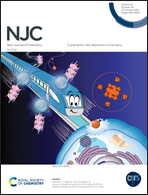Capture and characterization of elusive cyclo-di-BADGE†
Abstract
In a routine synthetic experiment, an elusive macrocyclic organic compound, namely cyclo-di-BADGE, was serendipitously acquired in a single crystalline form. This compound, widely known as a by-product from the co-polymerization reactions of bisphenol A (BPA) and bisphenol A diglycidyl ether (BADGE), has never been comprehensively characterized prior to this work. Herein, NMR and single crystal X-ray diffraction analyses have been conducted to investigate the molecular structural properties of cyclo-di-BADGE in the solution phase and solid state. Systematic conformational studies were carried out using the Conformer-Rotamer Ensemble Sampling Tool (CREST) in conjunction with density functional theory (DFT) calculations. Moreover, the aggregation behavior of cyclo-di-BADGE in organic and aqueous media was investigated through UV-Vis and dynamic light scattering (DLS) analyses. Detailed aggregation mechanisms were further probed by molecular dynamics (MD) simulations. Finally, we investigated the binding of cyclo-di-BADGE with a model protein, bovine serum albumin (BSA), through fluorescence and molecular docking analyses. Our studies provide valuable knowledge to facilitate the understanding of cyclo-di-BADGE in terms of its various physico-chemical properties and relevant effects on the environment and biological systems.



 Please wait while we load your content...
Please wait while we load your content...